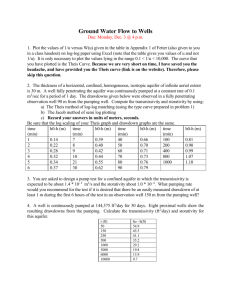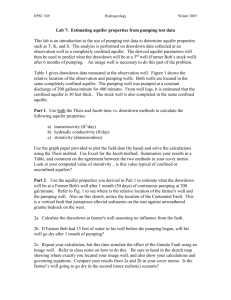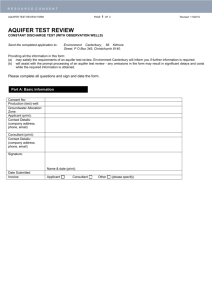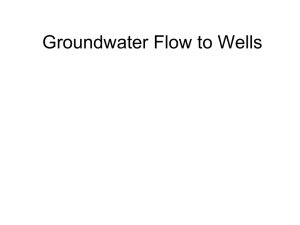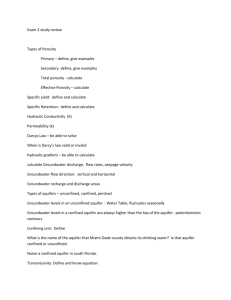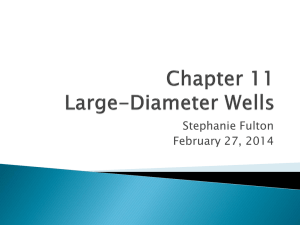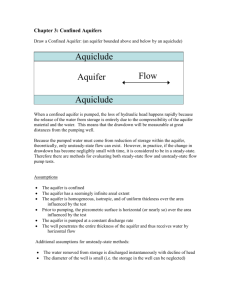Fetter_Ch7
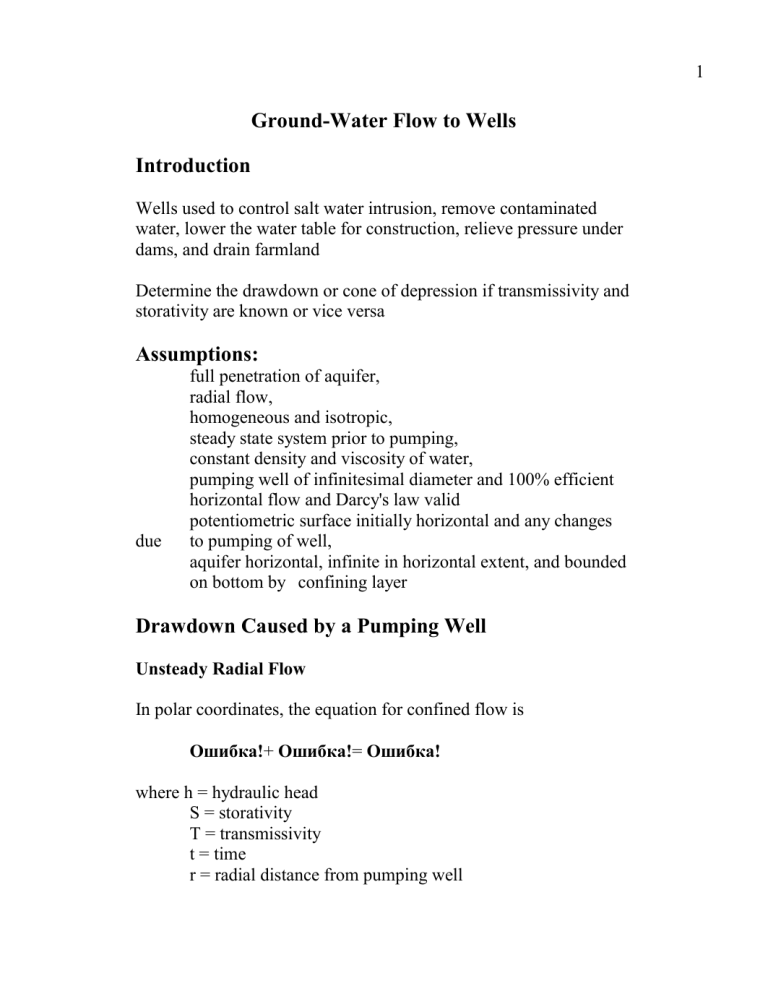
Introduction
Ground-Water Flow to Wells
Wells used to control salt water intrusion, remove contaminated water, lower the water table for construction, relieve pressure under dams, and drain farmland
Determine the drawdown or cone of depression if transmissivity and storativity are known or vice versa
Assumptions:
full penetration of aquifer, radial flow, homogeneous and isotropic, steady state system prior to pumping, constant density and viscosity of water, pumping well of infinitesimal diameter and 100% efficient horizontal flow and Darcy's law valid potentiometric surface initially horizontal and any changes due to pumping of well, aquifer horizontal, infinite in horizontal extent, and bounded on bottom by confining layer
Drawdown Caused by a Pumping Well
Unsteady Radial Flow
In polar coordinates, the equation for confined flow is
Ошибка!
+ Ошибка!
= Ошибка!
where h = hydraulic head
S = storativity
T = transmissivity t = time r = radial distance from pumping well
1
If there is leakage through a confining layer
Ошибка!
+ Ошибка!
+ Ошибка!
= Ошибка!
where e = rate of vertical leakage
Flow in a Completely Confined Aquifer
Assumptions - aquifer confined both top and bottom
Theis equation no source of recharge aquifer is compressible (can store water) well pumps at constant rate h
0
- h = Ошибка!
[
-0.5772 - ln u + u - Ошибка!
+ Ошибка!
- ...
]
= Ошибка!
w(u) where u = Ошибка!
h
0
- h = the drawdown
Q = pumping rate t = time since pumping began
Flow in a Leaky, Confined Aquifer
Ошибка!
+ Ошибка!
+ Ошибка!
= Ошибка!
2
Solution 1 - No water drains from the Confining Layer
Assumptions - aquifer bounded on top by aquitard and unconfined
aquifer (source bed);
water table in source bed initially horizontal and
does not change during pumping;
aquitard is incompressible and flow through it is
vertical;
aquifer is compressible (stores water)
Water table in source bed unchanged if t < Ошибка!
b"K" > 100 bK (source bed is large reservoir
compared to aquifer)
Aquitard is incompressible if t > 0.036b'S'/K' (time of pumping is large relative to amount
of water in storage) r < 0.04b[(KS s
/K'S' s
)] 1/2
Solution valid if well radius, r w
, meets the following 2 conditions: t > (30r w
2 S/T) [1 - (10r w
/b) 2 ] h
0 r w
/(Tb'/K') 1/2 < 0.1
Hantush-Jacob formula
- h = Ошибка!
W(u,r/B) where u = Ошибка!
3
B = (Tb'/K') 1/2 = leakage factor
W = leaky Artesian well function
Rate at which water is being drawn from elastic storage, q s
, at a specific time is q s
= Q exp (-Tt/SB 2 )
If the well is pumped long enough all of the water will be coming from leakage across the confining layer, this occurs when t > Ошибка!
and drawdown is found from h
0
- h = Ошибка!
K
0
(r/B) where K
0
= zero-order modified Bessel function
Solution 2 - Water drains from the Confining Layer
Early period of pumping t > b'S'/10K' h
0
- h = Ошибка!
H(u, ) where = Ошибка!
1/2
B = ( Ошибка!
) 1/2 q s
= Q exp(vt) erfc((vt) 1/2 ) where v = (K'/b')(S'/S 2 )
4
If sufficient time elapses, the aquifer will reach equilibrium (all of the water will be coming from the source bed) t > Ошибка!
] 1/2 ) if r w
/B < 0.01, then h
0
- h = Ошибка!
K
0
(r/B)
Flow in an Unconfined Aquifer
K r Ошибка!
+ Ошибка!
+ K where h = saturated thickness v Ошибка!
= S s
Ошибка!
z = elevation above the base of the aquifer
S
K s
= specific storage
K v r
= vertical hydraulic conductivity
= radial hydraulic conductivity water extracted by 2 mechanisms - elastic storage and specific yield
3 distinct phases of drawdown:
1) early - water released from elastic storage, follows Theis
nonequilibrium curve, flow is horizontal
2) middle - water table begins to decline, water derived from
gravity drainage, 3D flow, drawdown controlled by
anisotropy of aquifer and thickness of aquifer
3) late - rate of drawdown decreases, flow is horizontal, and
follows Theis curve with storativity equal to specific yield
Neuman's solution - unconfined aquifer, vadose zone not important initial water comes from specific storage eventually water comes from gravity drainage drawdown small compared to saturated thickness specific yield is at least ten times elastic storativity
5
h
0
- h = Ошибка!
W(u
A
,u
B
, ) where u
A
= Ошибка!
u
B
= Ошибка!
= Ошибка!
Determining Aquifer Parameters from Time-Drawdown Data
Aquifer Test Assumptions pumping well screened only in aquifer being tested observation wells screened only in aquifer being tested
All wells screened over entire thickness of aquifer
Steady-State Radial Flow (unlikely)
- well pumped at constant rate
- equilibrium (no change in head with time)
Case 1 - confined aquifer top and bottom
Q = (2 rb)K Ошибка!
= 2 rT Ошибка!
where Q = pumping rate
K = hydraulic conductivity b = aquifer thickness h = hydraulic head r = radial distance to well
T = transmissivity
If 2 observation wells, then can integrate and solve for transmissivity
Ошибка!
= Ошибка!
6
h
2
- h
1
= Ошибка!
ln( Ошибка!
)
T = Ошибка!
ln( Ошибка!
)
Case 2 - unconfined aquifer
Q = (2 rh)K Ошибка!
K = Ошибка!
ln( Ошибка!
)
Note - for steady state conditions canNOT determine storativity of aquifer as hydraulic head does not change with time
Nonequilibrium Flow Conditions
Theis Method (Nonequilibrium Radial Flow, Confined Aquifer)
T = [Q/(4 (h o
-h)]W(u)
S = Ошибка!
where T = transmissivity
Q = steady pumping rate h
0
- h = drawdown
W = well function u = dimensionless constant
S = storativity
Procedure
Generate W(u) versus u on log-log paper (from Appendix 1)
Plot Drawdown versus time on log-log paper
Overlay the two plots and match the curves
Select match point and read W(u), u, Drawdown and time
Use these values, plus Q and r from well to solve for T and S
7
